|
|
This stereo boombox with built- in mini- keyboard from 1984 (service manual date) is one of the rarest and most mythical Casio instruments, about that tremendous nonsense has been told on the internet. Thus first let me set clear that this thing has absolutely nothing to do with a Casio CZ-101, but is rather a 4 note polyphonic Casio PT-30 variant with arpeggio and a complex sequencer that can be played to and that saves its music files on compact cassettes. It also has nice rhythms with the same soft analogue percussion like PT-30.
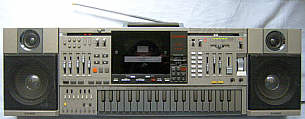 |
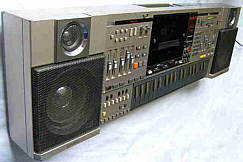 |
But for a portable boombox this thing is way too heavy; already without batteries it weights 6.7kg and additionally takes 8(!) heavy D size batteries. (I consider this a "boombox" and not a "ghettoblaster" because to me a ghettoblaster has no detachable speakers.) The detachable speaker boxes have not much bass, the trebles are slightly hissy and the speaker grills clang like a gong when knocked on, which is not really hi-fi, however among boomboxes there were far worse sounding yellbricks made than these ones, and listening to the FM stereo radio sounds fine. Unfortunately the speakers can be only enjoyed well with the tuner, because the cassette deck sounds bassles like a brandless 5EUR walkman and has no dolby despite it supports 3 tape sorts and is digitally controlled with all kinds of programmability nonsense gimmicks (shuffle play etc.) like a CD player. Annoying is also that you apparently can not record your keyboard play on cassette, because the tape deck switches into datasette mode and only saves digital sequencer data when 'record' is pressed while the keyboard is on. Even more annoying is this because additionally to the built- in stereo mikes and the normal microphone jacks there is even a jack for a DJ mixing mike with that you can mix your voice etc. into the sound of the boombox, which else could be used to record your singing together with keyboard play.
Important: I bought my Casio KX-101 extremely broken state without manual (on eBay in 2006 for still 44.50€). The PCB was partly smashed to pieces and it was a hell job to puzzle the zillion of traces together, thus I don't know if I repaired it correctly and how it was intended to behave like. Thus my description though may still contain errors due to undetected defects. But because this thing is unbelievable hard to find and I neither can nor want to pay insane moon prices those certain collectors demand for a working specimen, this was my only chance to get one to find out how it sounds and what's inside. Later I found a second KX-101 on a flea market for 30€, but this one was in almost the same bad condition and the PCB was cracked too.
The original German retail price of the Casio KX-101 in a German Conrad catalogue from 1986 was 1199DM (about 600€), which may be the reason why it is so rare because it likely didn't sell well for such an enormous price.
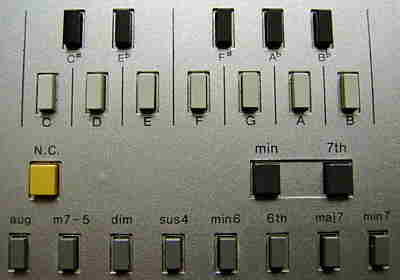 |
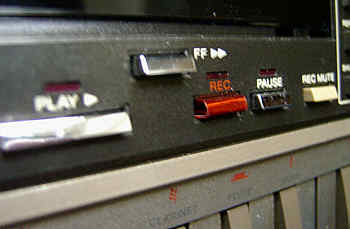 |
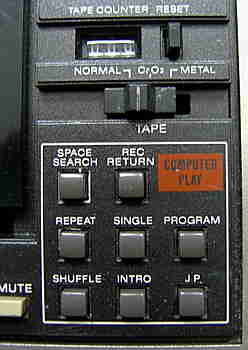 |
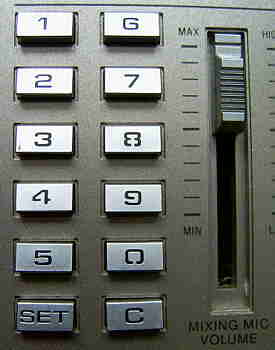 |
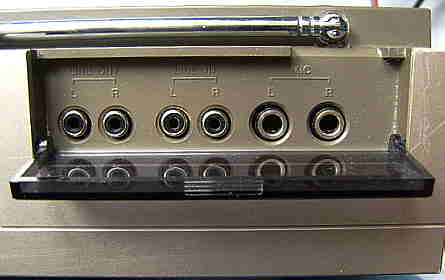 |
 |
 |
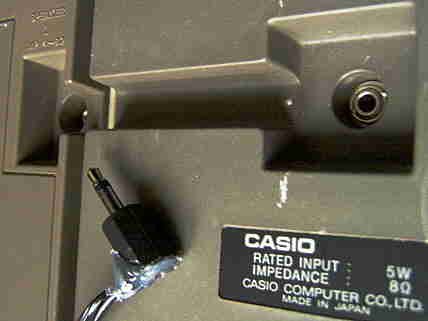 |
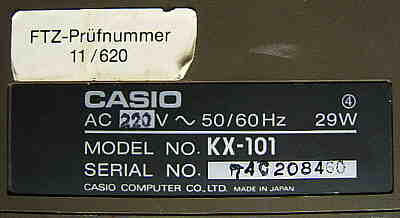 |
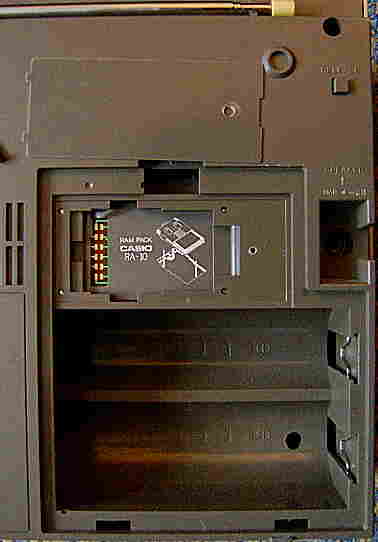 |
The extremely crowded and complex multi- chip hardware is a hell job to repair; a Casio PT-30 is really harmless compared to this. There are multiple PCBs with an incredible lot of discrete components, hybrid modules and cable mess inside, those are definitely the worst maintainable Casio keyboard hardware I ever saw. But because this rare thing is unbelievable hard to find and I urgently wanted to find out what it was, I bought my first KX-101 in very broken state. Only the tuner worked but everything else was dead; the tape motor was constantly buzzing and all keyboard LEDs were lit. It was an absolute nightmare to repair and this was very archeological, because not only the tape deck mechanism was dead, but the previous owner apparently ill-treated it with raw violence after successles repair attempts because the main PCB was shattered to small pieces around the tape sort selector and the screw below, the record knob was missing and the button switch underneath was drowned in superglue.
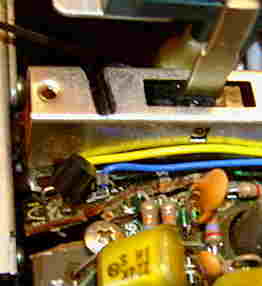 |
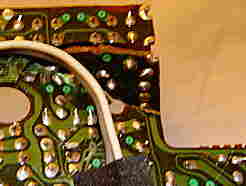 |
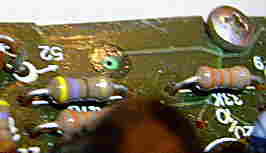 |
I patched the smashed PCB with lots of red coil wire. |  |
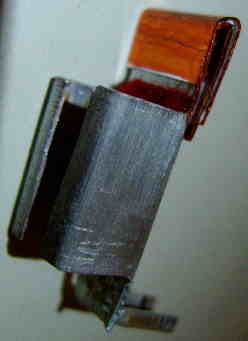 |
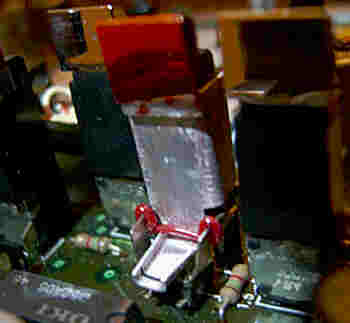 |

This is my homemade 'record' button. |
But despite intense PCB inspection I still don't know if I have repaired all PCB damages correctly, because some functions still behave a little odd; e.g. the sequencer saves data only to one stereo channel of the cassette drive; the other is much quieter, duller and depends on the actual slider settings. I also had no manual at that time (got the PDF later); fortunately at least I had a German Conrad catalogue from 1986, which explains on a whole page very detailedly e.g. the functions of the severely complex "computer play" cassette drive, which unlike modern CD players has no display and is almost impossible to figure out without documentation.
Some months later I found a 2nd KX-101 specimen on a flea market in the German city Bremen. Due to the absurd rarity makes it almost impossible to find spare parts, I bought this one too (vendor wanted 40€; I made the deal at 30€) despite it was in almost as awful condition as the 1st one. The cassette 'eject' button, 2 switch handles and both loudspeaker boxes were missing, the cassette door was unhinged and a cassette supporting post was cracked off. The case here was not warped but severely scratched at all edges. When I examined the hardware, it turned out that a potentiometer was broken and even the main PCB was cracked too - arrg! But at least the cracks were less severe than with my 1st specimen (only 2 cracks in the upper amplifier section), thus with repair routine from the previous one and some superglue it took me only some days to make it work. The cassette drive rubber tyres fortunately even were not that hardened; only the belts slipped and fell off the motor pulley like with my 1st KX-101.
warning: Be very careful with the Casio KX-101 not to drop it, and never lay any heavy objects on its control panel. It seems to be a typical failure of this model that the main PCB cracks apart when the switches or potentiometer knobs are pushed in by raw force. Especially the PCB section left to the amplifier sliders seems to be very prone to crack.
The main voice of the KX-101 is made from filtered squarewave with digital
envelope and zipper noise like with Casio
PT-30, but in opposite to the latter it is 4 note polyphonic and
in stereo, i.e. it alternatingly assigns notes to the left and right channel
(unless the amplifier is set to mono). The timbres have a dose of digitallic
harshness (DAC aliasing distortion?) but otherwise sound also a bit muffled.
Great is that when a key is trilled using sounds with sustain, each new
note occupies a new sound channel, which produces a great phasing sound
and volume increase effect although this eats up polyphony. (If you don't
like that, you can play monophonic by setting the "channel" switch to mono).
The "piano-1" is a typical squarewave piano (not really realistic); "2"
is slightly brighter while "3" has a halfway brassy timbre. "harpsichord"
sounds bright and thin, but still a bit too dull, and the attack phase
is too slow (like with Casio VL-1)
which makes it quite unrealistic. "organ" is a cross of the VL-1 "fantasy"
and a sonorous and slightly brassy multipulse squarewave pipe organ imitation;
it has 6Hz vibrato and some sustain, which sounds quite special; unfortunately
you can not play low bass notes on it, which would be much more exciting.
"horn" is the same with a more brassy timbre (the sudden end of the volume
envelope is more noticeable here). The "clarinet" also has 6Hz vibrato
and very short sustain; "flute" is the same in 1 octave higher and slightly
duller. "mellow" is a bizarre kind of synth vibraphone, which tremolo turns
faster and faster during decay of held notes (similar like a bouncing coin);
but unlike a vibraphone it has only very short sustain and no really percussive
attack. With the "unison" button the main voice can be switched to a detuned
stereo chorus mode that reminds to My Music
Center although it sounds not that cold. Unlike other Casios the
effect is not generated by postprocessing the sound, but it occupies additional
polyphony channels, thus the main voice turns monophonic in this mode.
 The
single finger chord and accompaniment correspond to the Casio
PT-30; unfortunately the chord buttons are here tiny like with
PT-20,
which makes chord play awkward. Also the analogue percussion corresponds
to the PT-30 and includes the same slow decaying transistor noise cymbals.
Unfortunately it has only 12 instead of 18 preset rhythms, but otherwise
it has 3 fill-ins (including accompaniment) and additional arpeggio. The
arpeggio is on the left stereo channel and steals the highest note channel
from the chord sound generator; at least with my specimen it adds quite
strong analogue distortion to the chord voice; I am not sure if this is
a defect or normal feature, but it can be also used as a sound effect.
When you play with the arpeggio button with arpeggio volume muted, you
can hear some arpeggio notes bubble through the chord channel. The
single finger chord and accompaniment correspond to the Casio
PT-30; unfortunately the chord buttons are here tiny like with
PT-20,
which makes chord play awkward. Also the analogue percussion corresponds
to the PT-30 and includes the same slow decaying transistor noise cymbals.
Unfortunately it has only 12 instead of 18 preset rhythms, but otherwise
it has 3 fill-ins (including accompaniment) and additional arpeggio. The
arpeggio is on the left stereo channel and steals the highest note channel
from the chord sound generator; at least with my specimen it adds quite
strong analogue distortion to the chord voice; I am not sure if this is
a defect or normal feature, but it can be also used as a sound effect.
When you play with the arpeggio button with arpeggio volume muted, you
can hear some arpeggio notes bubble through the chord channel. |
In chord mode the 'auto-1' button replays only the main voice while the 'auto' button replays the entire song. Although the instrument can as well record chords in realtime as play chords on the chord buttons during replay with 'auto-1', the instrument does not record any manually played chords during replay, thus you first have to record the chord voice separately and later synchronize it to the main voice using the 'one key play' buttons while the main voice is replaying with 'auto-1'. Regard that you must enter one step more than the count of chords (which stops the sequence); otherwise it will not be stored. Beside chord you can even record rhythm changes and fill-ins, but regard that the end of chord notes are not recorded automatically, thus you have to press the yellow 'N.C.' button to add a chord voice pause.
Beside the polyphonic main voice there is an additional monophonic main voice track (obligato?), which can be recorded the same way. It can use its own preset sounds and like with chords it can not be recorded during playback of other tracks, but only later synchronized to them using 'one key play' during replay of the other tracks with 'auto-1'. When the keyboard is in normal ('play') mode and 'channel' is set to "poly", then 'auto-1' will replay the monophonic voice track in the background while you can play the polyphonic voice manually. Setting 'channel' to "mono" does it vice versa, i.e. the polyphonic voice plays in the background while you can play the monophonic voice. The 'auto' button replays all recorded tracks together. (You can not play to this manually.)
When the 'keyboard' switch is set to the 3rd position with the note icon, you can edit the note lengths of a given track. In this mode the entire keyboard behaves like 'one key play', with the difference that every key now corresponds to a certain note length or pause length that is printed as a red icon below the natural and above the sharp keys. Some icons also seem to mute or trill individual notes, but this mode is quite confusing. (However the Roland TB-303 would not have produced its own patterns style when its editor would have been more obvious.)
Regard that the sequencer memory is not battery backed- up, thus it
is erased by power off. I am not sure if this is a defect of my specimen,
since this behaviour is uncommon for Casio keyboards (except the
bogus Casio SK-1). But otherwise the
auto- power off does not delete it, which makes a defect less likely, and
there are other means built-in to preserve the sequencer contents, because
with the "MT function" you can save them as digital data on audio cassettes.
For this simply insert a cassette with present record tab and press 'rec'
on the cassette deck while the instrument is in keyboard mode. This will
record the data file and stop the tape automatically. To load the file
again, switch to keyboard mode, wind the tape to the correct position and
press 'play'; this will automatically load and then play the sequence (or
a blip when the file is damaged). Regard that you have to press 'stop'
on the cassette deck now, because otherwise the instrument will attempt
to load the next file from cassette once the sequence has finished. This
was likely intended as a title search function or to create longer compositions
than possible with the internal memory. Strange is that my specimen saves
data only on one stereo channel while the other sounds much quieter, muffled
and changes its volume depending on the keyboard volume faders setting.
I don't know if this is a defect or if Casio just attempted to simplify
the circuitry to save cost. At least it increases the risk of faulty saved
data when half of the tape width stays unused.
I haven't tested yet if the data storage format of the KX-101 is compatible
with the TA-1 module of
the PT-30 and PT-50. 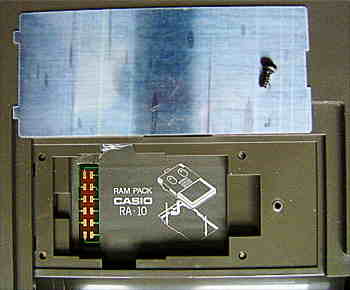 But
the existence of the 2nd main voice (obligato) in combination with commands
for selecting preset sounds, rhythms and fill-ins in the sequencer makes
the KX-101 capabilities strongly resemble the ROM-Pack
format supported by the PT-50, thus it could be possible that the KX-101
was even planned as a workstation for composing new ROM-Pack musics. However
the special RAM-Pack module Casio RA-10
that is supported by the KX-101 as sequencer memory expansion (the slot
is hidden in the battery compartment to expand the memory to 985 steps)
has no mechanical similarity with that RAM-Pack
RA-1
that fits into the ROM-Pack slot of PT-50. But
the existence of the 2nd main voice (obligato) in combination with commands
for selecting preset sounds, rhythms and fill-ins in the sequencer makes
the KX-101 capabilities strongly resemble the ROM-Pack
format supported by the PT-50, thus it could be possible that the KX-101
was even planned as a workstation for composing new ROM-Pack musics. However
the special RAM-Pack module Casio RA-10
that is supported by the KX-101 as sequencer memory expansion (the slot
is hidden in the battery compartment to expand the memory to 985 steps)
has no mechanical similarity with that RAM-Pack
RA-1
that fits into the ROM-Pack slot of PT-50. |
"computer play" buttons:
With many operations the drive winds the complete cassette from one end to the other - likely to scan how many titles are present or the like; at least this takes much longer than manually searching a title the old fashioned way. The drive is also claimed to support direct title selection through the number keypad and a tile search that skips up to 999 titles during fast forward and rewind, but I don't know how this works. The 'rec mute' button simply records a pause (empty tape) so long it is pressed during recording. (This simply disconnects the signal line to the recording head and is no digital feature.) Don't muse long what complex computer controlled things the "timer" switch may do - it simply does something that was a matter of course before computer controlled tape decks were invented, and there is really no clock inside. When set accordingly, it simply simulates a button press on 'play' or 'rec' as soon the boombox is powered on, to make it compatible with any plain ordinary mechanical mains socket timers to program a recording or playback time.
I am not sure if the number keypad is only used for tape deck controls,
or if is also used otherwise by the keyboard. In keyboard mode the cipher
buttons blip while a 3 digit number is entered. It would be fantastic when
Casio
would have used them for a hidden ADSR synthesizer like with
Casio
VL-Tone 1, but I don't think so.
repair & circuit bending detailThe Casio KX-101 is built around the main CPU "NEC D1868G 006" and sub CPU "NEC D1879G 002". The main CPU is wired to 2x SRAM= "Hitachi HD61914C" and generates the 4-note polyphonic main voice and controlls the percussion hybrid "K4F25S". The sub CPU generates chord, bass and arpeggio and apparently handles the cassette deck.
This device is definitely the worst maintainable piece of Casio hardware I ever saw. Thus do not attempt to repair it unless you really know what you are doing and have a lot of time. To open the case you have to pull off all the switch handles (which is hard to do without scratches since they fit very tightly), remove the back screws and press the 'eject' button to unlock the cassette door. Watch out that there are many different screw lengths; screwing them in wrongly may perforate the front panel. After taking off the case top, pull the front panel foil cables out of their sockets on the main PCB. Hang out the metal handle and the acryl jacks lid to prevent them from cracking off or damaging other parts. It is strongly recommended to make digital photos of all cables before dismantling because it is very hard to put them back correctly to make them fit again, and they also tend to crack off when moved too much. Small blobs of low temperature hot glue can help to prevent this, but be very careful that the glue won't collide with other things since the case is extremely crowded. main PCB:
power supply: The power supply is a plugged modules that sits in a separate chamber on the case back and has to be unscrewed from there when necessary. The one of my 1st KX-101 is a fixed voltage version for 220V, while my 2nd one has an additional rotary voltage selector (which empty PCB holes exists also in my 1st specimen). The power supply module of the 2nd has neither serial number nor default voltage printed on its KX-101 type plate, thus it was possibly a replacement part. Although the module is equipped with replaceable fuses, I recommend to power the electronics only by batteries (yes, 8 D-cells are heavy) during repair or experimentation. Regard that the cassette drive mechanism can get stuck after drive button presses when high- ohmed zinc carbon batteries are used.
cassette deck:
The cassette drive is digitally control and thus functions a little different than average ghettoblaster drives. Instead of using mechanical buttons, all functions beside eject are initiated by each a solenoid (magnetic coil) that flips a metal lever like in a relay. This slides a metal bolt into a special shaped plastic cog that has no teeth at one side, which also rotates the cog a little to make its teeth engage with a motor driven cog. The drive motor now rotates the cog further, which moves various sliders in grooves at the back side of the cog to shift spring loaded mechanical components. At the end of its motion the cog rotates again into a teethles position, where it is only held by the metal bolt so long the solenoid is powered. As soon the solenoid trips, the mechanism will flip back into its initial position by the spring load. attention: Regard that the cassette drive mechanism tends to get stuck after drive button presses when high- ohmed zinc carbon batteries or other weak batteries are used. (The power LED grows dim during this fault.) Insert full alkaline batteries or use the power supply to make the mechanism lock properly again. Regard that the cables on the PCB of the drive tend to tear off easily (happened multiple times to me), thus it is a good idea to stabilize them with hotglue. Thus when a single drive function fails, check these cables first. The drive solenoids are operated by a row of power transistors located on the left upper PCB under the main PCB. A dead transistor here would also make them fail. The record level is adjusted by 2 adjacent trimmers on the main PCB in front of the cassette drive. The drive determines its rotation speed by a small transistor- like magnetic sensor on a tiny PCB above the right cassette pulley. When bent, this thing tends to collide with the belt of the mechanical tape counter (which itself does not send any signals to the electronics). A damage of the sensor cables would cause the drive to stop always after few rounds. But the the cassette drive has one sever flaw: the rubber tires of the 4 tiny friction wheels in its center turn hard over time (by oil vapours and ozone, at least in my 1st KX-101) and thus slip, which causes tape mess by preventing the cassette pulleys from turning. To access these parts, you have to unscrew the rectangular central assembly of the drive from its bottom side. The friction wheels are held by a tiny plastic snap ring in its center. To remove these rings, pull them off with the finger nails between thumb and a finger, because with all other methods they tend to fly several meters away and are extremely hard to find again on the carpet. Now you should thoroughly remove the oil residues with a Q-Tip and isopropanol. Instead use a drop of silicone oil or silicone grease to lubricate the axle again, because any other oils damage rubber over time. The tiny rubber tyres can be removed from the wheels using a tiny screwdriver, but replacement tires are hard to find (my local electronics store knew no source for them). I tried to soften them many times in a jar full of boiling hot water without much success. The axle of 2 of the wheels sits on a tiny black plastic part that is squeezed against the other wheel by a thin wire spring. Bending these springs (take them out first) can help to increase the force, but be careful not to snap off the tiny plastic hooks on those the springs rest. During successles repair attempts of my first KX-101 I broke a spring and bent a new one from much stronger spring steel wire, which snapped off the plastic hook, but bending the spring against the bottom of the axle works also. Important was only that the stronger spring must not be bend too far because else it made the pulley rotate when the drive was in stop mode.
The slide mechanism of the head assembly also tends to get stuck by hardened oil. For cleaning it can be unscrewed from the top side, but be very careful not to loose the tiny steel ball that slides in a groove underneath. For a test turn the flywheel by hand while pressing the levers of the solenoid coils; when everything is ok, this should make the components slide into place without getting stuck (like during normal operation). When it gets stuck, take out the corresponding plastic cog (remove snap ring) and check why the bolt in its groove refuses to slide properly. With both specimen also a thin transmission belt had lost its strength (likely by oil vapours); as a temporary fix normal household rubber rings can be used although this may make the sound flutter a little more than a real belt. Generally the winding mechanism of the drive is too weak to wind certain cassettes back or forward, which is partly caused by the friction at the drive heads those permanently touch the tape here to detect pauses and digital data. The drive winds better when the cassette is pushed back (away from the heads) by about a millimeter. This can be done by pulling thin tubing (e.g. a piece of cable insulation) over the cassette supporting posts left and right to the heads. (With my 2nd KX-101 one post was cracked off, which I fixed by hotgluing a stiff wire to it that I coated with a piece of cable insulation.) But watch out that such a distance piece must not be too thick, because it else prevents proper contact between tape and heads. When you insert the drive again, watch out that all belts are placed correctly; especially the flat belt at the flywheel tends to slip off the barrel- shaped motor pulley (which makes the motor buzz abnormally). This happens especially when that pulley has been pushed too far down on the motor capstan, thus first try to pull or carefully pry the pulley up again. But with both my KX-101 specimen the belt still sometimes fell off the pulley during heavy load (e.g. during drive button operation with cassette inserted and weak battery). As a fix I mounted on the pulley a washer with a snap ring to keep the belt in place. (Watch out not to use a too large washer; else it will collide with the tuner PCB when the drive is installed.) RAM-Pack RA-10This RAM-Pack seems to be one of the rarest Casio accessories; I never saw a single specimen anywhere (neither for sale nor mentioned by owners). However it seems to be mechanically identical with various contemporary Casio calculator, pocket computer and data bank memory packs like OR-1 (1KB), OR-2 (2KB), OR-4 (4KB?), OR-20 (2KB) or Olympia EM545 (1KB) (seen on websites; I don't own them). It is unknown if any of these are electrically compatible with the KX-101 or may damage it by different pinouts. The KX-101 RAM-Pack slot has 2 rows of 6 pins, while e.g. the Radio Shack PC-4 (aka Casio FX-700P) pocket computer has one row of 11 pins (seen in service manual). But they all seem to be relatives of the RAM-Pack RA-1 that was designed for the ROM-Pack slot of Casio PT-50.circuit bending?The Casio KX-101 is very rare and has an extremely crowded case which makes it badly suited for circuit bending. Especially the digital main ICs sit on the back of the fragile main PCB where they can not be safely accessed for tests during operation, and there is very little space left for adding switches or potentiometers. However the percussion is analogue (with transistor noise?) and thus can be certainly manipulated well for many kinds of tekkno noises by connecting things to its capacitors and resistors, but unlike other analogue Casio percussion it has not even trimmers for decay time adjustment. The filter capacitors for the main voice seem to be controlled by 4066 ICs, those are like the rest of the keyboard sound hardware located at the left side of the main PCB. Regarding the complex sequencer with individual analogue faders, it could be certainly exciting to insert a genuine synth filter with resonance somewhere, which would make the thing a bit more TB-303- like. Also the control panel connector sits on the front of the PCB, where it can be well accessed for searching keyboard matrix eastereggs. (I haven't analyzed the hardware closer yet.)pinout D1879GThe "NEC D1879G 002" (80 pin SMD) is the sub CPU of Casio KX-101. It generates chord, bass and arpeggio tone (squarewave) and envelope and handles the cassette deck. The "002" is likely the software number of internal rom. Technically this is a variant of D1868G.This pinout is based on incomplete schematics from the Casio KX-101
service manual. I am not sure if the pin names are assigned correct, because
most are written between pins and there position can only be guessed. Because
this chip looks like a (software?) variant of D1868G, I assume pins of
equal name having same position and similar type of function (e.g. same
signal direction and level) but the purpose may be wrong because most were
only guessed from schematics wiring.
|
Apparently a few different Casio KX-101 model variants were released. While the power supply of my 1st specimen has a fixed 220V power supply, my 2nd one has a rotary switch (operated by screw driver) to select the mains voltage. While my 2 specimen have the text "COMPUTER PLAY, METAL" printed on the aluminium plate inside the cassette door, I saw on eBay a KX-101 which had there a big "CASIO" logo instead.
The instrument concept of the KX-101 is described in the US patents 4615024 (general) and 4656535 (with random access cassette sequencer). The patents also suggest an alphanumeric LCD and keyboard to enter song names, which was not implemented in the actual KX-101.
From my early childhood I remember that in the computer department of a German Horten shopping center (called the "Horten Computer- Center") in the Commodore C64 era there was a TV set with an advertisement video running in a loop, which explained the features of a Casio keyboard boombox and especially mentioned the sequencer with magnetic tape saving. But the strange thing is that I remember the case design very different from my KX-101. I definitely remember that it had a row of key lighting LEDs above the keys, and I think it had only 32 (slightly bigger?) keys without chord buttons (much like Casio PT-82) and the keyboard could be flipped in a 90° angle forward to play on it without laying the entire boombox on its back. I also remember that it had a grey front panel divided into horizontal sections with likely 3 knobs in a row (each about ø2cm) and the outer case sides were likely red. All corners and edges were slightly rounded and I think that the detachable speaker boxes had a silver or grey sheet metal grill with rounded corners and no visible tweeter. Also the cassette door was rather grey with rounded corners. I possibly also saw this thing in a Karstadt shopping center. Does anybody remember this boombox?
Another mysterious keyboard boombox was likely made by Elite or Elta; in mid of 1990th I saw a single specimen of it about 2 or 3 times on flea markets in the city Buxtehude; it was still in its (quite worn) original box., but I didn't buy it because at that time I didn't care that much about strange keyboards and had no space left in the single room where I lived. It had a white rectangular case with detachable speakers, likely a black control panel with silver knobs, black speaker grills and seemed to have a by 90° flippable mini keyboard at its lower case rim. The keyboard looked like a simple toy with only 2 or 3 sounds and very few rhythms (possibly based on the same hardware class like Fix und Foxi Musik Band or the Creatoy keyboard), and I think the keys were in standard white and black colour, even shorter than with KX-101 (likely only about 2 octaves). Also the case was smaller than my KX-101. To me at that time it looked like a cheap knockoff of the strange Casio boombox I saw in my childhood.
I finally got a version of it on eBay. It is the Radiotone
Granada RCX-KB 500, which seems ultra-rare (no info found online).
It has a silver metallic case with detachable speakers, indeed a row of
3 silver knobs on a black panel to the right of the cassette door,
and below it a chute with lid for mini keyboard on a short cable (3.5mm
stereo plug for +12V and audio). The keyboard can be removed but not be
fully pushed in for storage (case too shallow), so the 29 minikeys section
always sticks out at the front to collect dust. Despite only 4 rhythms
and 3 envelopeless organ tones, the thing has full polyphony and real analogue
percussion (on a fairly crowded PCB). Unlike Ramasio
892 the chips are branded (no COB), so it is likely older than
RJP
stuff and might be a relative of Sankei
TCH-8800. But it is lightweight and (unlike KX-101) radio and cassette
have no special features (but work ok). It looks very close to what I remembered
as Elite/Elta boombox (4 blue sliders above keys, but case not white -
possibly only its box rim was white with photo background light blue).
| removal of these screws voids warranty... | ||
 |
||
|
|